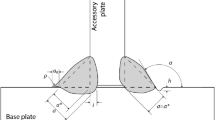Abstract
Historically, design against fatigue of welded joints is widely based on the nominal stress approach with categorized structural details and appropriate S-N-curves without any need of detailed numerical analysis. Recently, local approaches based on structural and notch stresses are of growing importance for the lifetime assessment of components without post-weld treatment for dominant elastic material behavior in high cycle fatigue (HCF), and for design against the endurance limit. Finally, high quality weld seams submitted to post-weld treatment such as grinding and TIG or plasma dressing and/or operating conditions in low cycle fatigue (LCF) with high plastic deformations are advantageously considered within a strain-based approach. A concept-conforming modeling strategy as a relevant module of lifetime assessment is required to ensure reliable and reproducible analysis results for all local approaches of design against fatigue. A unique modeling strategy based on an adaptive nominal weld seam contour is derived covering a wide range of typical welded pressure vessel joints for stress and strain based approaches. An alternative method for the determination of structural stresses is proposed to avoid the uncertainties of extrapolation and description of structural stiffness.
Similar content being viewed by others
Author information
Authors and Affiliations
Corresponding author
Rights and permissions
About this article
Cite this article
Rudolph, J., Weiß, E. & Forster, M. Modeling of welded joints for design against fatigue. Eng. Comp. 19, 142–151 (2003). https://doi.org/10.1007/s00366-003-0253-3
Issue Date:
DOI: https://doi.org/10.1007/s00366-003-0253-3




